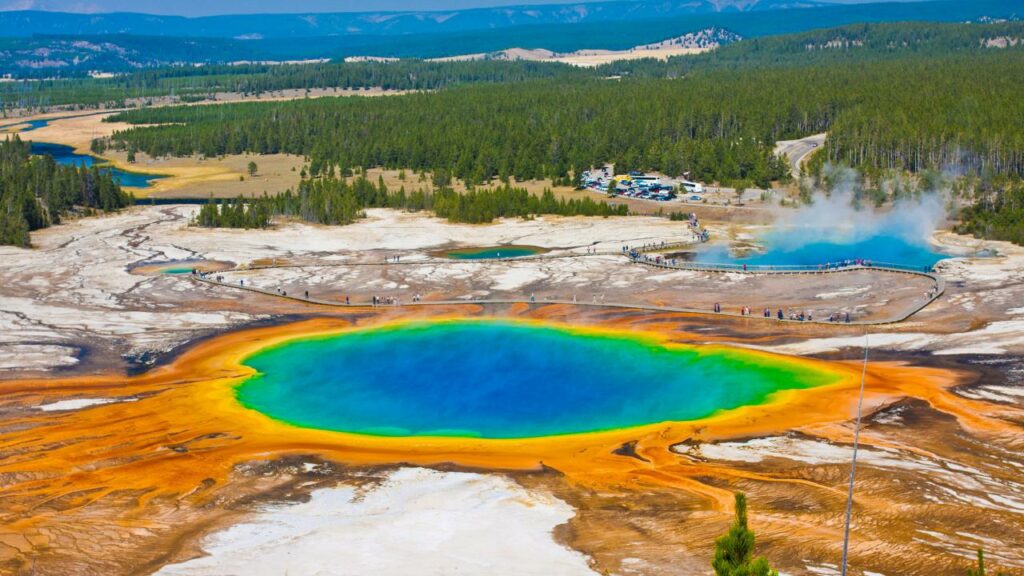Yellowstone National Park: A Majestic Tapestry of Wilderness and Wonders Across Wyoming, Montana, and Idaho

Introduction:
Yellowstone National Park, a sprawling masterpiece of nature that spans the states of Wyoming, Montana, and Idaho, stands as an unparalleled testament to the raw beauty and ecological diversity of the American West. Established in 1872 as the world’s first national park, Yellowstone remains a crown jewel in the United States’ protected natural spaces. This extensive exploration unveils the wonders that define Yellowstone, from its iconic geothermal features and diverse wildlife to its pristine landscapes and the delicate balance of its ecosystems.
Geothermal Marvels:
- Old Faithful:
- Old Faithful, Yellowstone’s most iconic geyser, captures the imaginations of millions of visitors each year. Its predictable eruptions, shooting hot water and steam into the air, symbolize the dynamic geothermal forces at play beneath the park’s surface.
- Grand Prismatic Spring:
- The Grand Prismatic Spring, a kaleidoscopic marvel, is one of the largest hot springs in the world. Its vibrant colors, ranging from deep blue to fiery red, result from the presence of thermophiles—microorganisms adapted to the extreme temperatures.
- Mammoth Hot Springs:
- Mammoth Hot Springs, with its terraces of travertine, showcases the ongoing geological processes that shape Yellowstone. The constantly changing formations and intricate terraces create a surreal landscape reminiscent of a living, breathing sculpture.
Wildlife Sanctuary:
- Bison Herds:
- Yellowstone is home to the largest and oldest public bison herd in the United States. Witnessing these magnificent creatures roaming freely across the park’s expansive meadows is a testament to the park’s commitment to preserving the natural behaviors of its wildlife.
- Gray Wolves and Grizzly Bears:
- Yellowstone is one of the few places in the contiguous United States where gray wolves and grizzly bears can still be found. The reintroduction of wolves in the 1990s has played a crucial role in restoring the park’s ecological balance.
- Elk and Pronghorn:
- The park’s diverse habitats support a rich array of wildlife, including elk and pronghorn. Visitors may encounter these graceful creatures while exploring Yellowstone’s varied landscapes, from lush meadows to high alpine regions.
Scenic Landscapes:
- Grand Canyon of the Yellowstone:
- The Grand Canyon of the Yellowstone, carved by the Yellowstone River, presents a breathtaking panorama of towering waterfalls and vibrant rock formations. Artist Point offers a particularly stunning vantage point for capturing the canyon’s awe-inspiring beauty.
- Yellowstone Lake:
- Yellowstone Lake, the park’s largest lake, stretches across 136 square miles and reflects the surrounding mountainous landscapes. Its pristine waters and scenic shorelines provide a serene backdrop for outdoor enthusiasts and wildlife alike.
- Norris Geyser Basin:
- The Norris Geyser Basin, the park’s hottest and most dynamic thermal area, features a striking landscape of steam vents, hot springs, and geysers. The otherworldly terrain serves as a reminder of Yellowstone’s geothermal heartbeat.
Historical Significance:
- Fort Yellowstone:
- Fort Yellowstone, established during the park’s early years, preserves the architectural heritage of the park’s administration. Visitors can explore the historic structures, including the Mammoth Hot Springs Hotel, which stands as a testament to Yellowstone’s enduring legacy.
- Heritage and Indigenous Connections:
- Yellowstone’s cultural significance extends beyond its natural wonders. Indigenous tribes, including the Shoshone and Bannock, have long-standing connections to the region, and the park collaborates with Native American communities to preserve and share their cultural heritage.
Outdoor Recreation:
- Hiking Trails and Backcountry Adventures:
- Yellowstone offers a vast network of hiking trails that cater to a range of abilities. From leisurely strolls around geothermal features to challenging backcountry treks, the park provides opportunities for exploration and immersion in its pristine wilderness.
- Fly Fishing and Water Activities:
- Rivers and lakes within Yellowstone provide ample opportunities for fly fishing and other water-based activities. Fishing enthusiasts can cast their lines in search of cutthroat trout, while kayakers and boaters can navigate the park’s scenic waterways.
Seasonal Changes and Unique Phenomena:
- Winter Wonderland:
- Yellowstone undergoes a magical transformation in winter, with snow-covered landscapes and frosty geothermal features. The park’s winter season offers unique opportunities for wildlife viewing, cross-country skiing, and snowmobiling.
- Bioluminescent Microorganisms:
- In the dark waters of Yellowstone’s thermal features, bioluminescent microorganisms create a mesmerizing display. These tiny organisms illuminate the depths, creating an otherworldly spectacle that highlights the park’s mysterious subterranean world.
Challenges and Conservation Efforts:
- Managing Visitor Impact:
- The popularity of Yellowstone poses challenges in managing the impact of increasing visitation on the park’s ecosystems. Sustainable tourism practices and educational initiatives aim to balance the enjoyment of visitors with the preservation of the park’s natural integrity.
- Wildlife Conservation and Habitat Protection:
- Ongoing efforts focus on preserving and restoring critical habitats for Yellowstone’s wildlife. Conservation initiatives address challenges such as habitat fragmentation and the impact of climate change on the park’s diverse ecosystems.
Conclusion: Yellowstone – America’s Wilderness Symphony
Yellowstone National Park, with its geothermal wonders, diverse wildlife, and pristine landscapes, stands as a living testament to the beauty and resilience of nature. Across the states of Wyoming, Montana, and Idaho, this remarkable wilderness symphony invites visitors to witness the harmonious interplay of geology, biology, and history. As the first national park in the world, Yellowstone continues to captivate and inspire, reminding us of the importance of preserving these natural treasures for future generations. Whether gazing at the erupting spout of Old Faithful, encountering a bison herd on a vast meadow, or hiking along the rim of the Grand Canyon of the Yellowstone, every moment in this majestic park is a celebration of the Earth’s wonders and the enduring legacy of America’s commitment to conservation. Yellowstone remains, in every season and every eruption, a sanctuary of wilderness and a beacon of the wild spirit that defines the American West.




